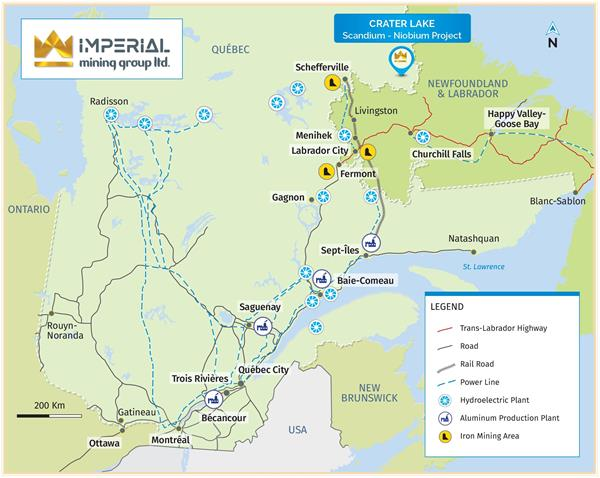Aug 17 2020
Imperial Mining Group Ltd, a Canadian mineral exploration and development company, reports that field crews performing sampling and mapping activities have now identified a number of new regions of scandium (Sc) mineralization on the wholly-owned Crater Lake project.
 Crater Lake property location map, Québec. Image Credit: Imperial Mining Group Ltd.
Crater Lake property location map, Québec. Image Credit: Imperial Mining Group Ltd.
The latest showings are located inside the same arcuate magnetic trend that spans 14 km and hosts the three formerly delineated mineralized zones—STG, TGZ, and Boulder—on the property.
Imperial Mining is expecting assay results in September 2020. At present, drill crews are moving to the property to begin drill assessment of the latest showings and to extend the identified STG and TGZ mineralized zones.
The new discoveries are extremely positive news for Imperial in view of the rapidly growing demand and limited supply for this important new technology metal. Scandium is showing increased demand for its use in high-strength, lightweight aluminum alloys in the aerospace, automotive, defense and alternative energy sectors.
Peter Cashin, President and Chief Executive Officer, Imperial Mining Group Ltd
Cashin continued, “Currently, scandium is only produced as a minor by-product in China and Russia and, with supplies limited, it is our belief that Crater Lake represents an important alternative, primary scandium supply source to serve western consuming markets.”
2020 Exploration Program
Abitibi Geophysics of Val d’Or, Québec, had recently completed a 130-line km program of comprehensive ground magnetic surveys at line spacings spanning 50 m. The aim was to further delineate the western corridor of the Crater Lake scandium mineralized trend.
The goal of the survey work is to (1) improve one’s understanding of the geometry of both existing and latest mineralized zones, (2) detect the presence of as-yet to be identified mineralization, and (3) improve drillhole targeting.
The latest survey will be complemented by a program of geological prospecting, mapping, channel sampling, and trenching across the recently identified mineralized regions—that is, Hilltop, South, and North.
At present, drill crews are moving to the property to finish at least six-to-eight drillhole programs to assess the economic viability of the recently identified mineralized regions and to widen the known mineralization regions at STG and TGZ. Avataa Rouiller Diamond Drilling of Amos, Québec, will perform the drilling operation.
The present program is scheduled to conclude in September 2020. A 2021 definition drill program of the highest-grade part of the mineralized trend will be planned in winter based on the assessment of data obtained through this work. The outcomes of the definition drilling, which is expected to be completed in the second quarter of 2021, will be used to prepare an I43-101 resource estimate.
Crater Lake Exploration History (2007 to Present)
In 2007, Quest Rare Minerals Ltd initially investigated Crater Lake as a rare earths prospect. This preliminary work led to the detection of the “Discovery Outcrop” that yielded up to 9.0% rare earth oxides and yttrium (REE) and also approximately 1000 g/t (0.1%) of Sc.
A strong and concentric, 6-km diameter magnetic anomaly was identified through an airborne geophysical survey concluded in 2008. The survey effectively defined the host Crater Lake Ring Dike Complex. The Sc is linked to a distinct and highly magnetic layer of mafic rock inside this intrusion.
Back in 2014, drilling by Quest Rare Minerals intersected a Sc-bearing zone (Boulder Zone) measuring 225-m long inside a thick and highly magnetic mafic intrusive layer that returned up to 167.8 m grading 260 g/t Sc, including 27.6 m grading 351 g/t Sc and including 62.8 m grading 304 g/t Sc.
Grades like these compare favorably with identified Australian laterite Sc deposits grading between 260 and 410 g/t Sc, a few of which are progressing to pre-production.
Imperial Mining concluded a five-hole, 1,014-m diamond drilling program on the TGZ mineralized zone in early 2019. This drilling program defined a 500-m wide mineralized zone in strike and to a vertical depth of 200 m. It also yielded remarkable grades of 95.5 m of 314 g/t scandium oxide (Sc2O3), such as113.9 m of 310 Sc2O3 and 16.3 m grading 353 g/t Sc2O3, including 354 g/t Sc2O3 across 12.0 m.
The mineralized deposit continues to remain exposed in all directions. Furthermore, channel sampling of the exposed mineralized regions across the STG mineralized zone yielded lengths of 7.04 m grading 0.364% REE and 289 ppm Sc2O3 contiguous to the magnetic high that delineates the highest-grade section of the target system. At present, the target system is not exposed in outcrop.
Scandium and Rare Earth Markets
The wider use of Sc in the aluminum alloys industry has been restricted by the limited availability of this element in western commercial markets from Russia- and China-based primary supply sources.
In addition, the absence of consistent long-term supply sources to offer material for further applications has restricted the market growth of Sc. This has led to relatively higher costs for Sc when compared to other competing alloy materials, like titanium, and has restricted its wider use. USGS has published the present cost of the metal oxide, which indicates that it is traded in a range of about US$2,000 to 4,000/kg for a purity of 99.99%.
Sc serves as a grain-hardener and refiner of aluminum alloys. Alloys of aluminum and Sc combine excellent strength, weldability, ductility, lower density, and enhanced corrosion resistance.
The combination of all these characteristics renders aluminum-scandium alloys suitable for the defense, automotive, and aerospace sectors. Aluminum alloys modified by Sc are extremely valued as a major lightweight material since they weigh 60% of titanium alloys and one-third the weight of steel.